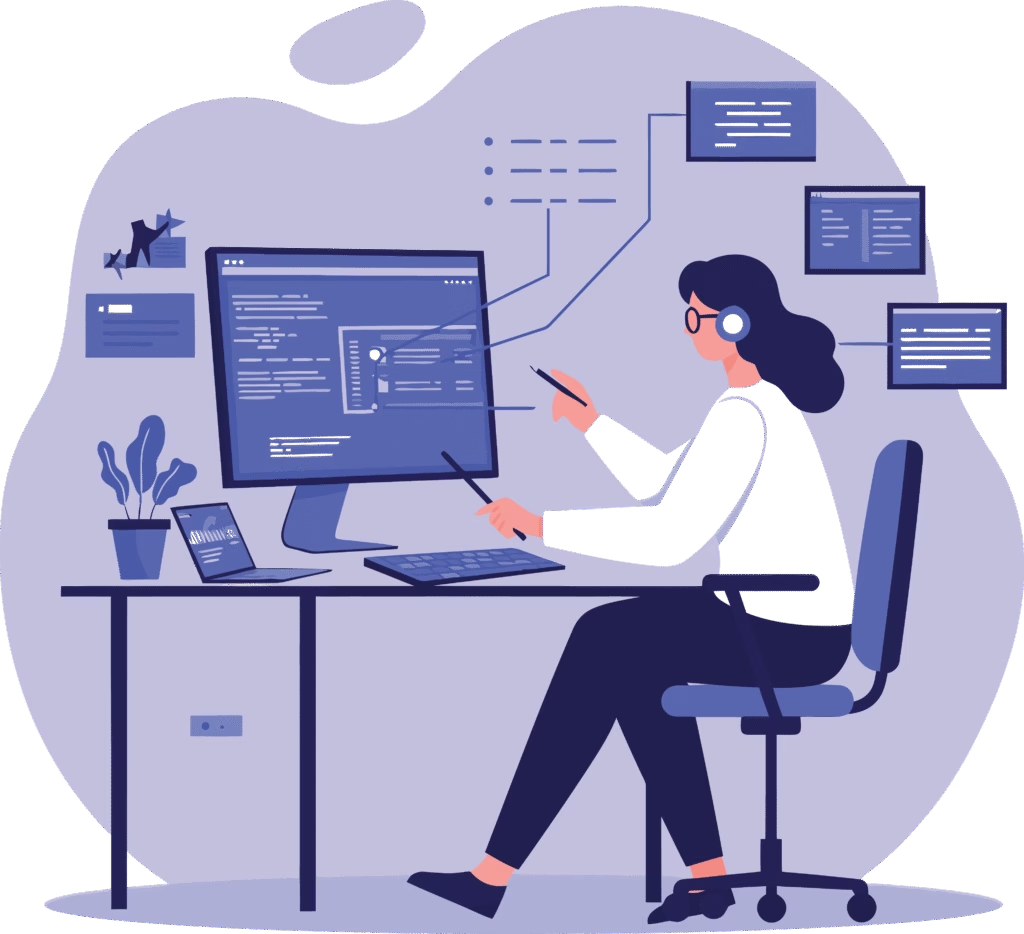The Evolution from On-Prem PBX to Cloud: Where UCaaS and CCaaS Fit In
Remember those massive PBX systems lurking in the server rooms of businesses everywhere? Those blinking lights, tangled cords, and physical desk phones that represented the pinnacle of telecommunication technology? Well, those dinosaurs are going extinct—and not a moment too soon.
Business communication has undergone a dramatic transformation over the past decade. The shift from on-premises PBX systems to cloud-based platforms marks one of the most significant evolutions in enterprise IT. As traditional phone systems fade into obscurity, two cloud-based solutions have emerged as the new champions of business communication: UCaaS (Unified Communications as a Service) and CCaaS (Contact Center as a Service).
The Painful Past of PBX
Traditional PBX systems were once considered revolutionary. They allowed organizations to manage internal calls without routing through public telephone networks, saving costs and centralizing control. Large corporations invested heavily in PBX infrastructure, often dedicating entire rooms to servers, switches, and wiring that looked like something out of a sci-fi movie from the 1980s.
However, these systems came with a host of headaches. Hardware costs were astronomical, upgrades moved at glacial speed, and scalability required purchasing new equipment and licenses—because nothing says “business agility” like waiting six weeks for a technician to install a new phone line. Each branch office needed its own setup, and system maintenance often required specialized IT personnel who spoke a language only other PBX technicians understood.
As companies expanded globally and remote work began to emerge, these on-prem systems started to feel about as flexible as a brick wall. Business communication remained tethered to physical locations and desk phones. Even small changes—such as adding a new employee—could take weeks to implement, by which time the employee might have already quit out of phone-less frustration.
Enter VoIP: The First Glimpse of Freedom
The first crack in the PBX monopoly came with Voice over Internet Protocol (VoIP). Instead of routing calls over traditional phone lines, VoIP converted voice into digital signals transmitted via the internet. Suddenly, organizations could bypass expensive telecom infrastructure and connect offices across the globe without having to sell the janitors kidney to pay for it.
VoIP introduced flexibility—users could make and receive calls on computers and mobile devices, and software began to replace physical phones. But early implementations weren’t exactly seamless. Bandwidth limitations, latency, and call-quality issues plagued adoption in the 2000s, leading to the classic “Can you hear me now?” dance that became a staple of early VoIP calls.
Still, VoIP laid the groundwork for something greater: the virtualization of communication systems. As cloud computing matured in the 2010s, the idea of hosting communications entirely in the cloud—managed by a provider, scalable on demand, and accessible from anywhere—became too compelling to ignore.
UCaaS: Unifying the Communication Chaos
Unified Communications as a Service (UCaaS) emerged as the natural evolution of VoIP and collaboration tools. Rather than treating phone, video, chat, and email as separate systems requiring different logins, passwords, and IT support tickets, UCaaS integrated them into one cloud-based platform that even the most technologically challenged employees could navigate.
UCaaS combines multiple tools—voice, video conferencing, instant messaging, presence, file sharing—into a single interface accessible from any device. Employees can jump from a chat to a call to a video meeting without switching applications, improving both speed and productivity. It’s like having all your communication tools in one digital Swiss Army knife, minus the tiny scissors that never quite work right.
For businesses, the benefits were immediate and compelling:
- Scalability: No need to install hardware or rewire offices. New users can be added instantly, not after a six-week wait and three missed appointments.
- Flexibility: Teams can communicate from anywhere—a critical capability for remote and hybrid work, or for those who just don’t want to put on pants to go to the office.
- Cost Efficiency: Subscription-based pricing replaces massive upfront capital investments, freeing up budget for more important things, like better coffee in the break room.
- Automatic Updates: The provider handles maintenance, security, and feature enhancements, so IT teams can focus on fixing the printer that somehow still jams every Monday morning.
By the mid-2010s, UCaaS platforms had become indispensable. Unified communication was no longer a luxury—it was a business necessity, right up there with electricity and working bathrooms.
CCaaS: Because Customers Deserve Better Than Hold Music from 1987
Where UCaaS focuses on internal collaboration, Contact Center as a Service (CCaaS) centers on customer interaction. Traditional contact centers, much like PBX systems, were on-premises, hardware-heavy environments that relied on expensive infrastructure to handle inbound and outbound calls—and customers still got stuck listening to the same terrible hold music.
As customers began to engage through multiple digital channels—voice, email, chat, social media, and SMS—legacy call centers struggled to keep up. Customers expected faster, more personalized, and omnichannel experiences, not just a voice telling them “your call is important to us” for the 15th time.
CCaaS addressed this by moving contact center operations to the cloud. It unified customer communication across all channels into a single platform, enabling agents to deliver consistent, contextual support without forcing customers to repeat themselves more times than a kindergarten teacher.
Key advantages include:
- Omnichannel integration: Voice, chat, SMS, and social all in one platform, so customers don’t feel like they’re talking to different companies depending on how they reach out.
- Scalability: Seasonal or campaign-based scaling became effortless, perfect for those holiday rushes when everyone suddenly needs to complain about their gifts not arriving on time.
- Analytics and AI: Real-time data and automation improved response times and quality, reducing the number of times customers threaten to “take their business elsewhere.”
- Remote operations: Agents could work from anywhere, ensuring business continuity and allowing them to answer calls in their pajamas (just like executives have been doing for years).
CCaaS solutions helped organizations turn their contact centers from cost centers into strategic customer experience hubs, proving that making customers happy isn’t just good karma—it’s good business.
The Convergence: When UCaaS and CCaaS Join Forces
Although UCaaS and CCaaS developed separately, their convergence was inevitable, like peanut butter eventually meeting jelly. Both are built on cloud communication principles—flexibility, integration, and user experience—and both aim to make communication less painful.
The lines between employee and customer interactions have blurred. A sales representative might use UCaaS to collaborate with colleagues on a deal, then seamlessly transition to CCaaS to handle a customer inquiry. A support agent might escalate a case internally using chat or video. It’s all part of the same conversation flow, just with different participants.
Modern businesses realized that communication doesn’t happen in silos—and neither should their technology. The integration of UCaaS and CCaaS creates a unified communication ecosystem where employees and customers coexist in the same digital environment, without the awkwardness of forced team-building exercises.
This convergence delivers tangible benefits:
- End-to-End Visibility: Managers can see how internal collaboration impacts customer outcomes, finally answering the age-old question, “Why did that deal fall through?”
- Faster Resolution: Teams can connect instantly across platforms to resolve issues in real time, reducing the customer’s wait time from “could have watched Titanic twice” to “barely finished a TikTok.”
- Consistent Experience: Customers receive the same level of service across every touchpoint, instead of feeling like they’re dealing with multiple personalities.
- Enhanced Data Insights: Unified analytics link employee performance with customer satisfaction metrics, proving once and for all who really deserves that “Employee of the Month” parking spot.
Why Businesses Are Making the Switch (Hint: It’s Not Just to Be Trendy)
Several key forces have accelerated the migration from on-prem PBX systems to UCaaS and CCaaS solutions:
- Remote and Hybrid Work: The pandemic solidified what had already begun—the decentralization of the workplace. With employees spread across homes, cities, and continents, cloud-based communication became essential for continuity and collaboration. The downside is the dreaded “You’re on mute” syndrome we are all so tired of saying.
- Customer Expectations: Modern consumers expect immediate, personalized service. Legacy PBX and call center systems simply couldn’t deliver that level of responsiveness without some serious technological wizardry.
- Cost and Operational Efficiency: Cloud models eliminate the need for physical infrastructure, reduce IT overhead, and offer predictable operating expenses through subscription pricing—no more surprise bills that make the CFO spill their coffee.
- Integration with Business Applications: Today’s communication platforms integrate with CRM, ERP, marketing automation, and ticketing systems—enabling end-to-end workflows that don’t require human sacrifice to set up.
- AI and Innovation: AI-driven analytics, natural language processing, and speech recognition are now standard in CCaaS and increasingly common in UCaaS, powering smarter interactions and deeper insights. It’s like having a team of digital assistants who never ask for time off.
The Future: More Than Just Fancy New Acronyms
The next frontier is already here: Experience Communications as a Service (XCaaS)—an emerging model that merges UCaaS and CCaaS under one umbrella. In this brave new world, communication is holistic. Sales, marketing, service, and internal operations all operate on the same data-rich communication backbone. AI analyzes interactions across the entire ecosystem, providing insights that drive both employee productivity and customer loyalty.
This unified approach promises not only operational efficiency but also a strategic advantage—enabling organizations to deliver truly consistent experiences at every interaction point, not just during the sales pitch.
How Techmode Makes Communication Painless
At Techmode, we’ve been watching this evolution closely while building solutions that address the real challenges businesses face when making the transition from on-prem to cloud communications. Our TechmodeGO platform integrates both UCaaS and CCaaS functionalities into one seamless system, hosted in private, triple-redundant AWS instances – not on shared, multitenant platforms like our competitors.
With our 99.999% uptime guarantee, U.S.-based concierge support team, and enterprise-level features at SMB pricing, we ensure your business doesn’t miss a beat during the transition. Our concierge-level implementation process takes the headache out of cloud migration, and our team of experts is available 24/7 to provide assistance. We maintain an NPS score of 85 (well above the industry average of 36) and an A+ BBB rating because we understand that communication isn’t just about technology—it’s about people connecting with people.
FAQs About UCaaS and CCaaS
Q: What’s the main difference between UCaaS and CCaaS?
A: UCaaS focuses on internal team communication and collaboration, integrating tools like voice, video, messaging, and file sharing. CCaaS is designed specifically for customer-facing interactions across multiple channels, including voice, chat, email, and social media.
Q: Do businesses need both UCaaS and CCaaS?
A: It depends on your specific needs. If you have significant internal collaboration needs AND customer service operations, then yes, having both (or an integrated solution) provides the most comprehensive communication ecosystem. Many organizations are finding that the integration of both solutions creates the most seamless experience for employees and customers alike.
Q: How complicated is it to transition from on-premise PBX to cloud solutions?
A: With the right partner, it doesn’t have to be complicated at all. Modern cloud communication platforms are designed to integrate with existing systems, allowing for phased migrations that minimize disruption. The key is working with a provider that offers comprehensive onboarding and concierge-level support.
Q: What about security concerns with cloud communications?
A: Today’s cloud communication providers typically offer more robust security measures than most on-premise systems. Features like end-to-end encryption, role-based access controls, and compliance certifications (such as HIPAA, SOC 2, etc.) ensure that your communications remain secure. Private cloud instances provide an additional layer of security for businesses with stricter requirements.
Q: How do UCaaS and CCaaS improve ROI compared to traditional systems?
A: Cloud communications reduce capital expenditures, eliminate maintenance costs, and offer predictable operational expenses through subscription models. Beyond direct cost savings, businesses see improved productivity through better collaboration, higher customer satisfaction through improved service, and increased agility to scale up or down based on business needs. The elimination of hardware obsolesce alone can save businesses thousands of dollars annually.










